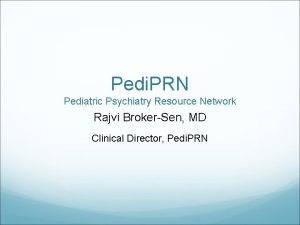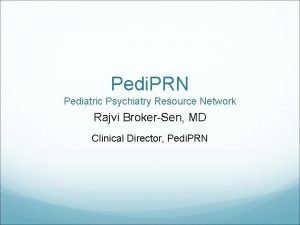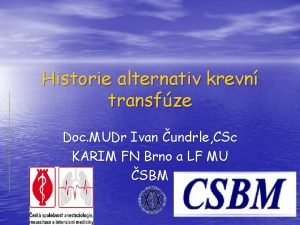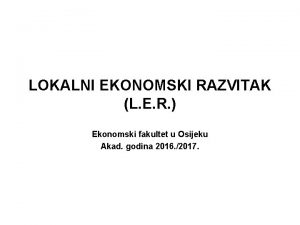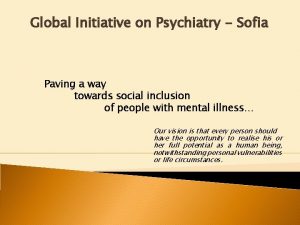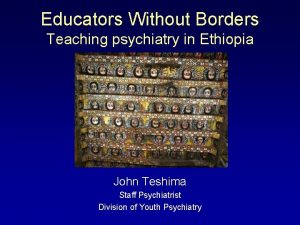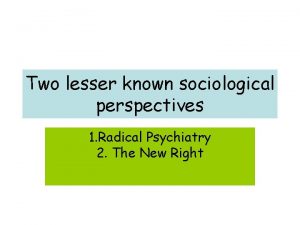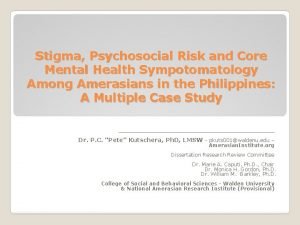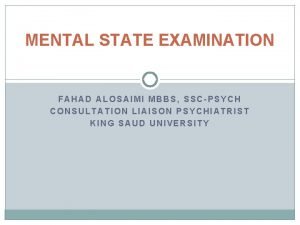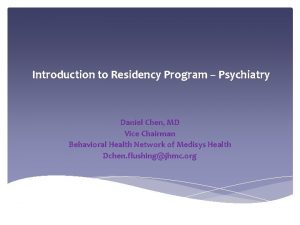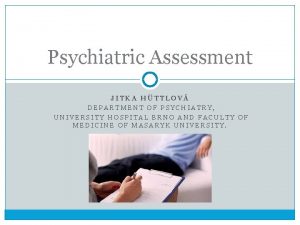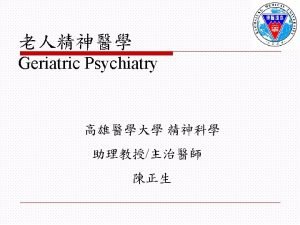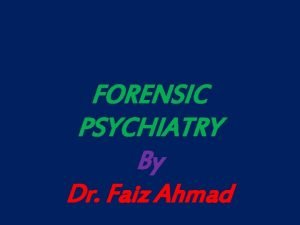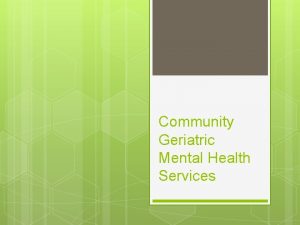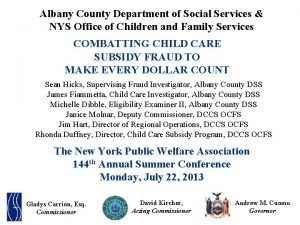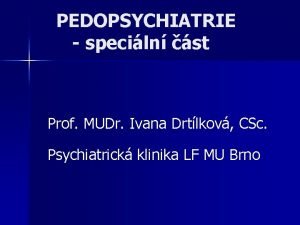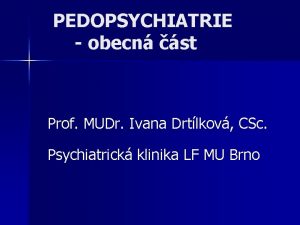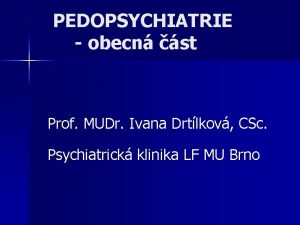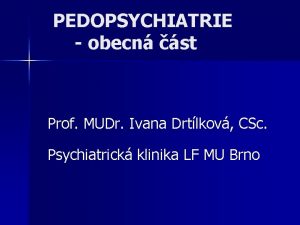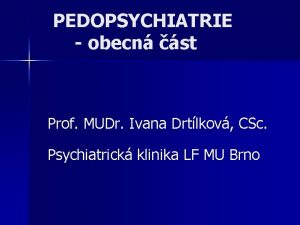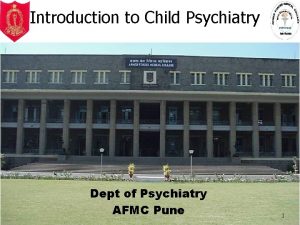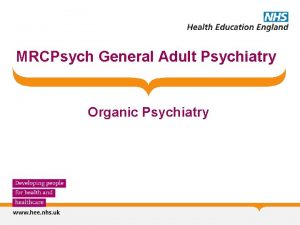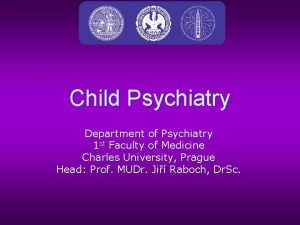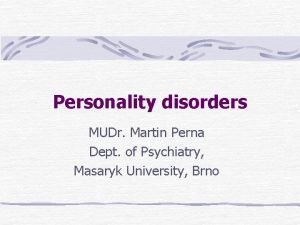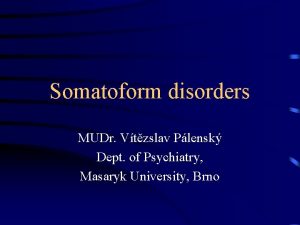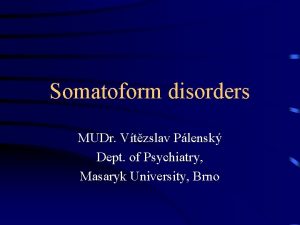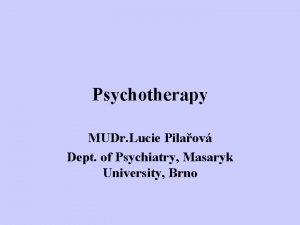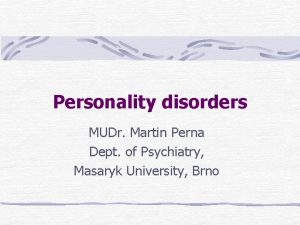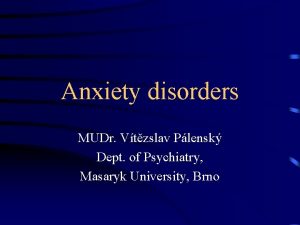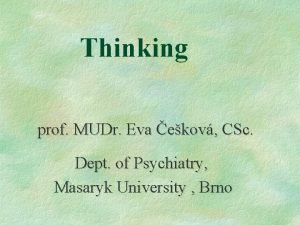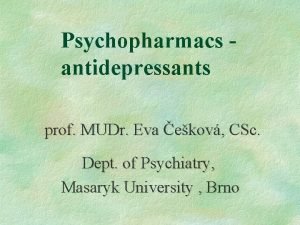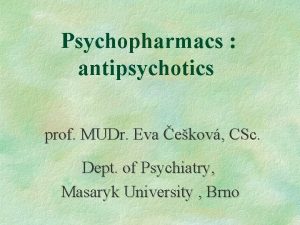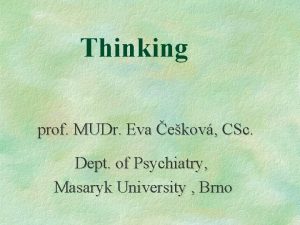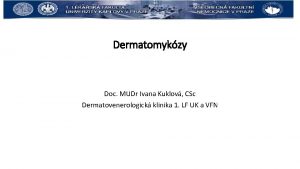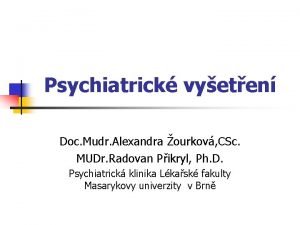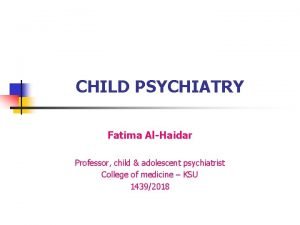Child Psychiatry Prof MUDr Ivana Drtlkov CSc Dept








































- Slides: 40

Child Psychiatry Prof. MUDr. Ivana Drtílková, CSc. Dept. of Psychiatry, Masaryk University , Brno

Child Psychiatry Conduct Disorder q q genetic and environmental components more common among boys(6 -16%) than girls (2 -9%)

Child Psychiatry Diagnosis : repetitive and persistent pattern of behavior in which the rights of others or basic social rules are violated. § Aggressive behavior that causes or threatens harm to other people or animals, ( bullying or intimidating others, initiating physical fights. . ), § Non-aggressive conduct ( property loss or damage, fire-setting. . ) § Deceitfulness or theft § Serious rule violations, ( running away from home overnight, often being truant from school. )

Child Psychiatry Treatment: family therapy, and cognitive behavioral approaches which focus on building skills such as anger management. Pharmacological intervention alone is not sufficient. .

Bed-Wetting (Primary Nocturnal Enuresis) Bed-wetting is accidental urination during sleep. § children over age 5 or 6 ( age at which continence could definitely be expected) § Bed-wetting that develops after a child has been dry for a period of time (secondary nocturnal enuresis)

Bed-Wetting (Primary Nocturnal Enuresis) Cause for bed-wetting: o o o Delayed growth and development. Small bladder capacity. Lack of enough antidiuretic hormone (ADH). Sound sleeping. Psychological and social factors.

Bed-Wetting (Primary Nocturnal Enuresis) Medications : o that either increase the amount of urine that the bladder can hold bladder capacity- (imipramine) o or decrease the amount of urine released by the kidneys ( desmopressin).

TIC DISORDERS Tics are : abrupt, purposeless, and involuntary vocal sounds or muscular jerks. They are sudden, rapid, and recurrent. 1. Transient tic disorder - the most common type , with symptoms lasting at least four months, but no longer than one year. Onset - nearly 10 percent of school childrenmore prevalent in periods of stress, fatigue, or as a result of certain types of medications ( stimulants)

TIC DISORDERS 2. Chronic tics- lasting more than one year 3. Tourette's disorder (TD) Tourette's disorder is an autosomal dominant disorder with incomplete penetrance. Non-genetic cause in 10 to 15 percent of children (complications of pregnancy, low birthweight, head trauma, carbon monoxide poisoning, and encephalitis. . ).

TIC DISORDERS 3. Tourette's disorder (TD) Tourette's disorder (TD multiple repeated tics (abrupt, purposeless, and involuntary vocal sounds or muscular jerks. ) Begin : between the ages of 5 and 10 years of age

TIC DISORDERS Tourette a disorder - symptoms may include: involuntary, purposeless, motor movements (the face, neck, shoulders, trunk, or hands) § head jerking § squinting § blinking § shrugging § grimacing § nose-twitching

TIC DISORDERS Tourette a disorder - symptoms may include: § § § any excessively repeated movements (i. e. , foot tapping, leg jerking, scratching) kissing pinching sticking out the tongue or lip-smacking making obscene gestures

TIC DISORDERS Tourette a disorder is also characterized by one or more vocal tics : § § § § grunting or moaning sounds barks tongue clicking sniffs hooting obscenities throat clearing, snorts, or coughs

TIC DISORDERS Tourette a disorder is also characterized by one or more vocal tics : § § § squeaking noises hissing spitting whistling gurgling echoing sounds or phrases repeatedly

CHILDHOOD SCHIZOPHRENIA Definition: Same diagnostic criteria apply to children, adolescents, and adults Based symptoms : deficits in adaptive functioning, and duration of six months Incidence : less than 1/10, 000 births

CHILDHOOD SCHIZOPHRENIA General Characteristics: 1. Slight male predominance 2. Less educated and professionally successful families 3. Patients have low-average to average range of intelligence 4. Patterns of behavior before a formal diagnosis: attention/conduct problems, earlier patterns of inhibition, withdrawal and sensitivity

CHILDHOOD SCHIZOPHRENIA General Characteristics: 5. Disease is rarely observed before age 5 6. 80% of children have auditory hallucinations; 50% have delusional beliefs 7. Can be observed with additional conditions such as: conduct disorder, learning disabilities, mental retardation, and autism 8. Poor prognosis if onset before age 10 with above personality difficulties

CHILDHOOD SCHIZOPHRENIA CHARACTERISTIC SYMPTOMS : Positive symptoms ( productive ) : Delusions Hallutiations Disorganised speech (often incoherence ) Grossly disorganized or catatonic behavior

CHILDHOOD SCHIZOPHRENIA CHARACTERISTIC SYMPTOMS : Negative symptoms ( nonproductive ) : affective flattening social dysfunction Problematic in children - fantasy figures, which would not of themselves suggest psychosis. The content of hallutiations and delusions varies with age.

CHILDHOOD SCHIZOPHRENIA TREATMENT : Antipsychotics are the drugs of first choice in chilhood for schizofrenia Imortance : minimizing any cognitive dulling in school children , atypical antipsychotics are preferred (risperidone, olanzapine).

DEPRESSION IN CHILDERN Risk factors in their lives which could predispose: family history of mental illness or suicide, • abuse (physical, emotional or sexual), • chronic illness and the loss of a parent at an early age to death, • divorce or abandonment. • The depression could be wholly chemical, wholly due to psychological factors, or combination of the two.

DEPRESSION IN CHILDERN Symptoms of Depression in Children • • • Persistent sadness and/or irritability. Low self-esteem or feelings or worthlessness. A child may make such statements as, "I'm bad. I'm stupid. No one likes me. " Loss of interest in previously enjoyed activities. Change in appetite (either increase or decrease). Change in sleep patterns (either increase or decrease).

DEPRESSION IN CHILDERN Symptoms of Depression in Children • • • Difficulty concentrating. Anger and rage Headaches, stomachaches or other physical pains that seem to have no cause. Changes in activity level( more lethargic or more hyperactive. ) Recurring thoughts of death or suicide.

DEPRESSION IN CHILDERN If the child has bipolar disorder, also known as manic depression, these symptoms could be present: • abrupt, rapid mood swings • periods of extreme hyperactivity • prolonged, explosive temper tantrums or rages • exaggerated ideas about self or abilities Bipolar disorder is often mis-diagnosed as attention-deficit disorder with hyperactivity (ADHD), obsessive-compulsive disorder (OCD), oppositional defiant disorder or conduct disorder.

AUTISM IN CHILDREN First described : Leo Kanner in 1943 as a disturbance of affective contact Prevalence: 4 -5 cases per 10000 The basic criteria : 1) early onset (before 3 -5 years of age), 2) severe abnormality of reciprocal social relatedness, 3) severe abnormality of communication development, 4) restricted, repetitive and stereotyped patterns of behavior, interests, activities, and imagination; 5) abnormal responses to sensory stimuli.

AUTISM IN CHILDREN SOCIAL DISTURBANCE The human face holds little interest for the autistic infant § lack of eye contact, poor or absent attachments § general lack of social interest COMMUNACATIVE DISTURBANCE echolalia, pronoun reversal, inappropriate cadence and intonation, impaired semantic development

AUTISM IN CHILDREN COGNITIVE DEVELOPMENT Most ( approximately three-fourths ) autistic children scored in the mentally retarded range A few autistic individuals exhibit truly remarkable abilities( musical or drawing ability. memory BEHAVIOR FEATURES Restricted repetitive and stereotyped patterns of behavior, interests and activities. Interest in nonfunctional aspects of objects ( taste or feel )

AUTISM IN CHILDREN Stereotyped movements ( hand flapping, toe walking, spinning objcts and the like). Bizare affective responses - panicked in response to new situations. Deficits in imaginative play.

AUTISM IN CHILDREN ETIOLOGY AND PATHOGENESIS There may be a genetic basis to the disorderfamily members with other related disabilities Autistic children exhibited : an increased frequency of physical anomalies, persistent primitive reflexes, various neurological soft sings and increased abnormalities on EEG. Treatment Drug treatments ( risperidone ) Otherapies : behavioral treatments (teaching autistic "appropriate" behaviors).

Attention deficit hyperactivity disorder ( ADHD) CHARACTERISTIC : 1). INAPPROPRIATE OR EXCESSIVE ACTIVITY 2). POOR SUSTAINED ATTENTION 3). DIFFICULTIES IN INHIBITING IMPULSES IN SOCIAL BEHAVIOR AND ON COGNITIVE TASKS. 4). DIFFICULTIES GETTING ALONG WITH OTHERS 5). SCHOOL UNDERACHIEVEMENT PREVALENCE : 8 % OCCURS BETWEEN 6 - 8 YEARS IN BOYS - 9 % IN GIRLS - 3 %

Attention deficit hyperactivity disorder ( ADHD) Type of disorder ADHD combined type ADHD predominantly inattentive type ADHD predominantly hyperactive-impulsive type

Attention deficit hyperactivity disorder ( ADHD) Cause of ADHD suspected contributing factors may include: Neurophysiology - differences in brain anatomy, electrical activity and metabolism. Catecholamine function are very probably involved in the pathogenesis of hyperactivity. Genetics - possible gene mutations may be present.

Attention deficit hyperactivity disorder ( ADHD) Cause of ADHD suspected contributing factors may include: Drugs - drug use (nicotine and cocaine) by the mother during pregnancy. Lead - chronic exposure - influence behaviour and brain chemistry. Lack of early attachment - traumatic experiences related to the attachment

Attention deficit hyperactivity disorder ( ADHD) Therapy of ADHD • behavioural management, psychological counselling • drugs target the brain's neurotransmitters ( stimulants, antidepressants. . ) Stimulant drugs Dexamphetamine and methylphenidate (Ritalin) work by acting on the neurotransmitters that release the chemical dopamine. About 7 O % of children with hyperactivity improve on a stimulant regimen.

Attention deficit hyperactivity disorder ( ADHD) Inattention criteria • Fail to give close attention to details or make careless mistakes in school work. • Have difficulty sustaining attention in tasks or play activities. • Not seem to listen when spoken to directly. • Not follow through on instructions and fail to finish school work, chores or duties in the workplace

Attention deficit hyperactivity disorder ( ADHD) Inattention criteria • Have difficulty organising tasks and activities. • Avoid, dislike or be reluctant to engage in tasks that require sustained mental effort • Lose things necessary for tasks or activities (for example: toys, school assignments, pencils, books or tools). • Be easily distracted. • Be forgetful in daily activities.

Attention deficit hyperactivity disorder ( ADHD) Hyperactivity-impulsivity criteria Hyperactivity • Often fidgets with hands or feet or squirms in seat. • Often leaves seat in classroom or in other situations in which remaining seated is expected. • Often runs about or climbs excessively in situations in which it is inappropriate

Attention deficit hyperactivity disorder ( ADHD) Hyperactivity-impulsivity criteria Hyperactivity • Often has difficulty playing or engaging in leisure activities quietly. • Is often 'on the go' or often acts as if 'driven by a motor'. • Often talks excessively

Attention deficit hyperactivity disorder ( ADHD) Hyperactivity-impulsivity criteria Impulsivity • Often blurts out answers before questions have been completed. • Often has difficulty waiting in turn. • Often interrupts or intrudes on others (for example, 'butts into' conversations or games).

Child Psychiatry References : Child and Adolescent Psychiatry, edited by Melvin Lewis, Wiliams and Wilkins, 1996, 1260 pp.
 National network of child psychiatry access programs
National network of child psychiatry access programs National network of child psychiatry access programs
National network of child psychiatry access programs Doc. mudr. ivan čundrle csc
Doc. mudr. ivan čundrle csc Prof. dr. sc. ivana barković
Prof. dr. sc. ivana barković Addiction psychiatry expert witness
Addiction psychiatry expert witness Forensic psychiatry vs forensic psychology
Forensic psychiatry vs forensic psychology Gipsofia
Gipsofia Psychiatry in ethiopia
Psychiatry in ethiopia Radical psychiatry sociology
Radical psychiatry sociology Core psychiatry
Core psychiatry Site:slidetodoc.com
Site:slidetodoc.com Daniel chen md
Daniel chen md Assessment skills
Assessment skills Asclepiades father of psychiatry
Asclepiades father of psychiatry Nbme shelf exam percentiles 2019
Nbme shelf exam percentiles 2019 Define criminal psychiatry
Define criminal psychiatry Geriatric psychiatry definition
Geriatric psychiatry definition What is the difference between neurosis and psychosis
What is the difference between neurosis and psychosis European psychiatry
European psychiatry Community geriatric psychiatry
Community geriatric psychiatry 이진트리 복사 순회
이진트리 복사 순회 Hoe dept
Hoe dept Mn dept of education
Mn dept of education Geaux biz login
Geaux biz login Florida dept of agriculture and consumer services
Florida dept of agriculture and consumer services Gome dept
Gome dept Finance department organizational chart
Finance department organizational chart Dept ind onegov
Dept ind onegov Rowan county dept of social services
Rowan county dept of social services Pt dept logistik
Pt dept logistik Battalion chief interview questions
Battalion chief interview questions Affiliation poster
Affiliation poster Ms department of finance and administration
Ms department of finance and administration Oxford dept of continuing education
Oxford dept of continuing education Florida dept of agriculture and consumer services
Florida dept of agriculture and consumer services Nyttofunktion
Nyttofunktion Department of inspectional services
Department of inspectional services Albany county dept of social services
Albany county dept of social services Nys department of homeland security
Nys department of homeland security Maine dept of agriculture
Maine dept of agriculture Vaginal dept
Vaginal dept
